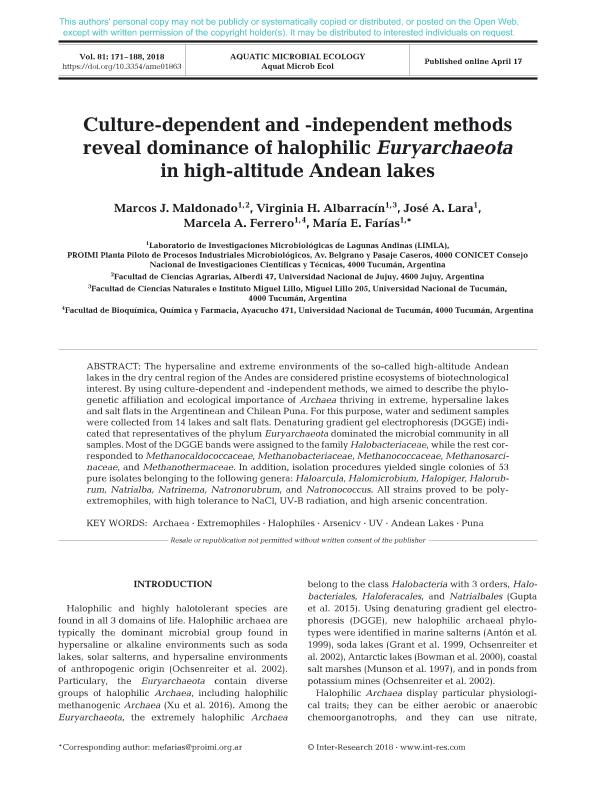Artículo
Culture-dependent and -independent methods reveal dominance of halophilic Euryarchaeota in high-altitude Andean lakes
Maldonado, Marcos Javier; Albarracín, Virginia Helena ; Lara, José Augusto
; Lara, José Augusto ; Ferrero, Marcela Alejandra
; Ferrero, Marcela Alejandra ; Farias, Maria Eugenia
; Farias, Maria Eugenia
 ; Lara, José Augusto
; Lara, José Augusto ; Ferrero, Marcela Alejandra
; Ferrero, Marcela Alejandra ; Farias, Maria Eugenia
; Farias, Maria Eugenia
Fecha de publicación:
04/2018
Editorial:
Inter-Research
Revista:
Aquatic Microbial Ecology
ISSN:
0948-3055
Idioma:
Inglés
Tipo de recurso:
Artículo publicado
Clasificación temática:
Resumen
The hypersaline and extreme environments of the so-called high-altitude Andean lakes in the dry central region of the Andes are considered pristine ecosystems of biotechnological interest. By using culture-dependent and -independent methods, we aimed to describe the phylogenetic affiliation and ecological importance of Archaea thriving in extreme, hypersaline lakes and salt flats in the Argentinean and Chilean Puna. For this purpose, water and sediment samples were collected from 14 lakes and salt flats. Denaturing gradient gel electrophoresis (DGGE) indicated that representatives of the phylum Euryarchaeota dominated the microbial community in all samples. Most of the DGGE bands were assigned to the family Halobacteriaceae, while the rest corresponded to Methanocaldococcaceae, Methanobacteriaceae, Methanococcaceae, Methanosarcinaceae, and Methanothermaceae. In addition, isolation procedures yielded single colonies of 53 pure isolates belonging to the following genera: Haloarcula, Halomicrobium, Halopiger, Halorubrum, Natrialba, Natrinema, Natronorubrum, and Natronococcus. All strains proved to be polyextremophiles, with high tolerance to NaCl, UV-B radiation, and high arsenic concentration.
Palabras clave:
Archaea
,
Extremophiles
,
Halophiles
,
Arsenicv
,
Halophiles
,
Arsenicv
Archivos asociados
Licencia
Identificadores
Colecciones
Articulos(PROIMI)
Articulos de PLANTA PILOTO DE PROC.IND.MICROBIOLOGICOS (I)
Articulos de PLANTA PILOTO DE PROC.IND.MICROBIOLOGICOS (I)
Citación
Maldonado, Marcos Javier; Albarracín, Virginia Helena; Lara, José Augusto; Ferrero, Marcela Alejandra; Farias, Maria Eugenia; Culture-dependent and -independent methods reveal dominance of halophilic Euryarchaeota in high-altitude Andean lakes ; Inter-Research; Aquatic Microbial Ecology; 81; 2; 4-2018; 171-188
Compartir
Altmétricas



